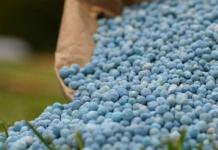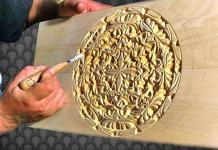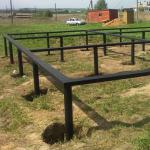The main lawn care is carried out in the spring: sow the grass, remove debris, decorate the edges, and eliminate any bald spots that have arisen. There will be less of this work if you work hard in the fall. To do this, they regularly mow, aerate, and apply phosphorus-potassium fertilizers. At the final stage, the plants are prepared for unfavorable winter conditions, so that in the spring the lawn will delight you with its beautiful green cover.
Autumn procedures - moisturizing, haircut, feeding
Lawn care is a responsible task, since it depends on whether the sown seeds will sprout, whether the grass cover will be of high quality, and whether pests will attack the green crop.
Autumn procedures are carried out from September until the first half of October, until frosts begin. These include the following activities:
- watering;
- a haircut;
- fertilization;
- earthing;
- soil aeration;
- repair;
- preparation for winter.
Haircut as it grows
If in the summer you had to mow the lawn almost every week, then in the fall this procedure is carried out less frequently. Soil temperatures drop and plant growth slows. If you stop mowing, the regrown grass will wither and lie on the ground with the onset of frost. And in the spring it will become an obstacle to the emergence of new shoots. Therefore, by winter the grass cover is mowed.
The number of autumn haircuts depends on weather conditions. If the Indian summer drags on, the lawn will have to be mowed several times. When early frosts set in, you may not have time to complete the last procedure. It is recommended to carry it out half a month before the first frost, so that the grass can grow up to 8 cm by winter. In the northern regions and Siberia, the final mowing occurs in the second ten days of September. In the middle zone it is carried out in the first half of October, in the southern regions - from late October to early November.
Guessing what the weather will be like and predicting the time of the last haircut is difficult. Therefore, you should continue to mow your lawn as it grows. It is recommended to leave the grass height at least 5 cm and no more than 10 cm, so that it does not spend a lot of energy on restoration, but retains nutrients for the winter. On clay soils, it is necessary to add drainage measures to mowing.
Grass clippings can be used in garden beds as mulch and natural fertilizer.
Top dressing - application rules
Before wintering, be sure to add mineral supplements, which include potassium and phosphorus. They promote the development and strengthening of roots, increase resistance to disease. Nitrogen is stopped applied in August, as it stimulates plant growth, which will be unnecessary in the autumn.
Be sure to read the instructions before using fertilizers to ensure they are applied correctly and in the right doses. It is better to fertilize lawn grass a few days after cutting, preferably in the evening. Otherwise, there is a risk of harming the greenery. The product must be distributed evenly throughout the entire area.
You can purchase a ready-made balanced complex fertilizer for autumn lawns, which contains all substances in the required proportions. Its main task is to prevent the growth of green mass and enhance nutrition of the root system. Diammophosk N10P20K20 meets these requirements. It contains a minimum of nitrogen and equal parts of potassium and phosphorus. Apply at the rate of 2 kg per hundred square meters.
The following mineral fertilizers are also suitable for lawn grass:

There are many nutrients in ash and bone meal. Experts recommend applying manure before winter - 3-4 kg per 1 square meter. m.
After the procedure, be sure to water the ground if rain is not expected, and do not disturb the lawn for a week.
Watering and irrigation
Regular moistening is not required in the fall, as seasonal rains suffice. If the weather is dry, it is enough to water the lawn once a week by sprinkling. The procedure is performed in the first half of the day so that the soil is well saturated with water. Care must be taken to ensure that no puddles form.
The last time watering is carried out in the first half of October. Next, irrigation is stopped to avoid waterlogging of the soil, as this can lead to root rot and plant death.
Cleaning and combing
After mowing, the lawn is thoroughly cleaned of mown grass and fallen leaves. If this is not done, the grass cover will lose its attractiveness under a layer of uncollected plant debris. It will rain, high humidity will cause diseases of the root system.
It is better to clean every week using a fan rake. Additional benefits of using them are that they loosen the soil and lift the plants. You can work with leaf raking models with plastic and metal flat teeth. They do not injure the stems and root system.

You should comb out thoroughly at different angles, but try not to damage the roots. This procedure will allow new shoots to develop better next year, resulting in a denser lawn. At the same time you need to fight the moss. If it is not possible to remove it mechanically, they resort to herbicides that contain iron sulfates, ammonium sulfates and sand without lime.
Useful soil piercing
An important autumn procedure is aeration. It performs the following tasks:
- When watering, it allows liquid to quickly penetrate into deep layers, preventing moisture from stagnating and puddles and ice crusts forming on the soil surface.
- After the summer season, the soil becomes compacted, which makes it difficult for plants to obtain nutrients. Piercing makes the soil loose, allowing oxygen and useful macro- and microelements to reach the root system faster.
- Increases plant resistance to frost. Air has low thermal conductivity: the more of it there is in the soil, the longer the heat is retained.
Aeration involves piercing the top layer of soil to a depth of 10-15 cm every 30 cm. If the area is small, then use ordinary garden forks.

For large areas, they use aerators with electric and gasoline engines, walk-behind tractors with a special nozzle. Electric models are easy to maintain, while gasoline models have increased power.
Particular attention should be paid to areas where children most often walk, place garden furniture, or play. The more punctures, the better the air flows. And excess moisture after cold rains freely goes into the deep layers of the soil. If it lingers, frost can turn it into ice, which will negatively affect the roots of plants. The procedure can be started in September and carried out in dry weather.
Leveling the site
It is better not to repair the lawn by planting young grass in the fall. She will not have time to grow and get stronger before frost. But there are a number of preventive measures you can take at this time of year. For example, level the lawn by spreading a mixture of sand and leaf humus evenly over it, filling small holes and compacting it immediately. It is better to leave significant depressions for the spring season.
Along the edges of the lawn area, it is necessary to eliminate overgrown greenery, remove the mounds and level them in the same plane with the rest of the covering. Pour a special mixture of herbs into the gaps formed, which is enriched with fertilizers that promote rapid seed germination. From above these areas are covered with a leaf-earth mixture. It retains moisture well.
It would be useful to carry out earthing - scatter fertile soil evenly over the lawn and lightly compact it. This will level the site, enrich the soil with useful substances, and prepare it for the next season. In the future, the grass will become more fluffy and dense. You can mix peat with compost and sprinkle the entire area. This will increase the fertility of the soil, which has been depleted over the season.
Cold weather care
You can also take care of your lawn in winter. There are a number of rules that should be followed with the onset of cold weather:
- In rainy and frosty weather, it is better not to walk on the lawn. If it is necessary to carry out work, you should lay down boards and step on them, not on the grass.
- Until the lawn is covered with snow at least 15 cm thick, the load on the grass cover should be reduced to a minimum.
- The lawn cannot be used as a skating rink.
- When clearing paths, do not dump snow on the lawn area.
- During a thaw, the ice crust that has formed on the lawn should be broken with a garden rake to provide air access to the plants.
If you carry out all the autumn activities: mowing, cleaning with a fan rake, aeration, fertilizing, then in the spring the lawn will quickly recover after winter and will delight you with its emerald color throughout the summer season.
A neat, well-groomed green lawn will give your suburban area a finished look, highlight and make other decorative elements of the area brighter and richer: trees, a pond, flowers, shrubs, alpine slides. The lawn needs constant care throughout the warm season. With the arrival of autumn, your grass carpet needs to be properly prepared for winter. We will tell you what and how to do this in this article.
Do you even need to prepare your lawn for winter?
It would seem - why? This is ordinary grass, which in natural conditions overwinters well without any preparation. All this is true, but we are talking about lawn grass, which is more “delicate”, and if you do not take care of the lawn in the fall, then in the spring it may “please” you with numerous bald spots, or the grass will have to be re-sowed. This is especially true for lawns that are awaiting their first winter.
Required tools and materials
- Lawn mower or walk-behind trimmer.
- Garden forks or aerator.
- Fan rake.
- Fertilizers - about 3 kg per 100 sq.m.
- Lawn grass seeds for overseeding
How to prepare your lawn for winter
At the beginning of autumn, in September, when the summer heat subsides and sufficient rainfall falls, it is not necessary to regularly water the lawn. But if September turns out to be dry, you can water the lawn using the sprinkling method. Remember that moisture evaporates much worse in autumn than in summer; do not allow puddles to form in the grass.
Every experienced gardener begins to prepare his lawn for winter from the beginning of September. Preparatory work is carried out until the first frost. At the beginning of October, it is recommended to completely stop watering the lawn to avoid the accumulation of excess moisture in the soil. If this is not done, the grass may weaken, become diseased, and die.
last lawn mowing
As all lawn owners know, in the summer the grass has to be cut almost every week. When autumn comes, the earth begins to cool, plant growth slows down and this procedure does not have to be carried out as often. But you can’t neglect mowing your lawn before winter. If the grass grows a lot, then with the onset of frost it will freeze and lie on the ground. In the spring, this carpet of dead plants will be difficult to remove and will greatly interfere with young shoots. Therefore, lawn care in the fall includes mandatory grass cutting.
The most suitable mowing height is about five centimeters. After this, within a few weeks the lawn will grow by 2-3 centimeters. This height of grass cover is best suited to preserving strength and nutrients for the upcoming winter.
It is quite difficult to guess how many times you will have to mow your lawn in the fall. If you mow your lawn in early September, the grass will likely grow back and will have to be mowed again. Or the opposite situation is possible, when early frosts strike and you do not have time to mow the grass for the winter. In the northern regions of the country, it is best to mow the lawn for the winter around the end of September, in the middle zone at the end of September - beginning of October, in the south - in the middle and even the end of October.
It is better not to throw away the cut grass, but to use it as fertilizer. Thus, you will solve the problem of recycling grass mass, and at the same time reduce the amount of spring work in the garden or garden bed. If you follow the general recommendations of experienced gardeners, the last mowing of the lawn should be done approximately two to three weeks before the first frost in your region.
feeding

In order for plants to quickly recover from winter frosts and begin to grow steadily, they need to be fed with mineral fertilizers. As for the composition of fertilizers, there is no consensus. Some gardeners recommend fertilizing the lawn in the fall using phosphorus and potassium fertilizers. We can agree with them, since phosphorus and potassium stimulate root formation of grass. Others advise using nitrogen fertilizers to promote rapid development of green mass. Ideally, it is necessary to combine all these types of fertilizers in the right proportions.
It would be a good idea to feed your lawn with nitrogen fertilizers throughout the summer. This will help deepen the color of the grass so it won't fade before frost.
It is also recommended to use deoxidizing agents - limestone flour or chalk. This will benefit not only the lawn, but also the nearby plantings. It is best to choose a dry and windless day to feed the grass.
soil aeration
It is strongly recommended to include aeration in the complex of preparatory work. Aeration, or airing the soil, has a very good effect on the condition of the lawn. It should be noted that aeration in the summer is undesirable. The optimal time for ventilation is early or mid-September. The essence of this work is very simple - holes or cuts are made in the soil, thus ensuring free access of air and nutrients to the roots of the plants. Soil aeration can be done in two ways - piercing and piercing.
In the first case, the soil is pierced to a depth of at least 8 centimeters. For work, you can use regular forks or a mechanical aerator. Piercing the soil is quite difficult work and takes a lot of time. Therefore, it is advisable to do piercing only in those places where puddles do not dry up for a long time after watering, or where the grass dries out in hot weather.
Spinning is used to improve turf, the fibrous layer of which inevitably becomes denser over time. To do this, lightly disturb the turf to a depth of no more than 4 centimeters.

Piercing is done using two types of aerators: with solid teeth or an aerator with cutting plates. Impaling is carried out over the entire area of the lawn in dry weather.
soil mulching

Over time, the soil on your lawn becomes uneven. The reason for this is regular intensive watering, mechanical stress and seasonal temperature changes. As a result, the soil loses nutrients necessary for the normal development of plants. The grass becomes faded and loses its original rich green color. To maintain the “health” of the lawn at the required level, mulching is carried out - the lawn is sprinkled with a mixture of peat, sand and fertile soil for the winter. Mulching is most often carried out simultaneously with fertilizing. This will save time and increase the efficiency of both procedures. Mulching allows you to increase the turf layer, so that the grass begins to grow better and the soil is protected from drying out. This type of protection is very important for your lawn.
The mulching procedure is best carried out in late September or early October. The composition of the mixture depends on the soil. If the soil is clayey, then the mixture of sand and peat has the following proportion: 1:4:2. For loamy soils the proportion will be 4:1:2. All ingredients must be dry. The mixture is evenly scattered over the surface of the lawn at the rate of 1.5 kg per 1 square meter. m.
protection against moles

And at the end of our publication, we want to remind you about such a danger to the lawn as moles. The fact is that by autumn a large number of insects and larvae appear in the soil, which provide an excellent treat for the mole. Several of these nimble animals can thoroughly “plow” your lawn in a short time, nullifying all our efforts. Therefore, you should not wait until the first mole appears on your lawn, but stock up on the necessary repellents and traps in advance.
We hope that after reading this material the question “how to prepare a lawn for winter?” won't bother you anymore.
Some summer residents, when planting a green lawn in the spring, do not even think about the fact that caring for the lawn in winter is one of the important stages in maintaining the beauty and health of the grass.
The procedures for maintaining the attractive appearance of your site after winter are not so difficult to implement. In this article you can learn how to prepare your lawn grass for winter and what to do to avoid unwanted hassle after a long winter.
How to prepare your lawn for winter?
To protect the lawn from adverse influences, as well as to preserve the turfy layer of soil as much as possible, preparing the lawn for winter should begin in September.
The most important procedure to ensure a comfortable microclimate under thick snow is aeration. Such care will ensure proper air exchange, and during the season of autumn and spring rains, as well as melting snow, it will create favorable moisture circulation. To prepare your lawn for winter care in this way, you will need an aerator or sharpened forks.
If you are just thinking about creating a beautiful green meadow, you can prepare the soil for the lawn in advance. To do this, clear and level the area, and then roll it tightly with a garden roller. After the snow melts, you can start planting grass almost immediately.
When is the last time to mow the lawn before winter?

Lawn grass goes through several stages of development before winter - from active growth on sunny autumn days to complete drying. The intensity of its growth depends on weather conditions and may vary depending on the region. Of course, leaving thick grass cover in the winter is not the wisest decision. But when to mow the lawn before winter, if the weather is so changeable?
- End of September – October (for the middle zone);
- October – November (for warm regions).
It is advisable to mow the grass before winter if the weather is stable and rainy or if there are night frosts. It is during this period that the cold actively affects the tender stems, gradually inhibiting their growth.
You can learn how to mow lawn grass in the fall in one of our articles.
Autumn fertilizer for the lawn
In order for your green lawn to continue to please you for a long time, you need to regularly use special fertilizers. Fertilizing the lawn in the fall is a mandatory procedure, allowing the soil to replenish its supply of useful microelements, minerals and humic acids.
Complex fertilizers for autumn application are different:
- Organic;
- Mineral;
- Organo-mineral.
In our store you will find a special complex autumn fertilizer (“OMU autumn”) - this is a balanced complex of substances necessary to protect the soil and grass from winter cold. It contains the entire necessary list of substances that activate grass growth in early spring.
You can find out how and when to apply autumn fertilizers in one of our articles or in the instructions for fertilizing.
Lawn care in autumn - preparing for winter

In order for your area to recover faster from winter cold, rain and unstable spring weather, caring for your lawn grass in the fall should be especially thorough. The most necessary procedures that need to be performed:
- Removing decorative elements and debris from the surface;
- A haircut;
- Scarification and aeration;
- Fertilizing the lawn before winter.
As additional measures, procedures can be carried out to remove weeds, insect pests, as well as sowing new grass.
After fertilizing, you can also mulch. This procedure involves cutting the grass and then using it as a thermoregulating layer. This type of care is especially important for young surfaces whose roots have not yet formed a dense turf layer. In addition, finely ground shoots are an excellent plant fertilizer. Read more about this procedure in our special article.

In this section we have collected useful recommendations from experienced gardeners and landscape designers. Our advice will help you get answers to all frequently asked questions - when to apply fertilizer for lawn grass, how to carry out vegetation care procedures, what to do to protect your lawn from diseases and pests.
- To prevent stains and bald spots from appearing on the site, you should not throw snow from the paths onto the lawn. Long melting of snow in the spring can significantly deteriorate the appearance of your coating.
- When should you apply complex autumn fertilizer? We recommend fertilizing the soil only after all necessary procedures have been carried out. It is better if the fertilizer is in solid granular form.
- Winter grass varieties will help speed up spring growth. If you want luxurious greenery as quickly as possible, plant some bluegrass or ryegrass. These varieties ripen the fastest.
By following these simple rules, you can not only protect your lawn from winter cold, but also provide it with proper nutrition and active growth in the spring.
One of the fashionable trends in modern private country houses has become the lawn - a well-groomed green lawn located directly in front of the main building or on most of the site.

Many owners, mistakenly thinking that such a clearing will grow well without proper care, are often disappointed. If used improperly, without periodic fertilizing and weeding, or without proper mowing, lawn grass quickly becomes clogged with weeds, withers, falls to the ground and looks terrible. It is quite difficult to cover all the features of lawn maintenance in one article, so today we will talk about mowing in general and autumn mowing in particular.
Lawn in landscape design
Mowing is one of the main types of lawn care. It begins in mid-May or earlier, depending on natural conditions. The main characteristic that determines the start of spring mowing is the length of the grass. When this indicator reaches 10 centimeters, it is recommended to carry out the first haircut. The goal of the procedure is to give the plants an optimal length of 4-5 centimeters. Shorter grass quickly withers due to drying out of the soil and can die completely, especially during the hot period of the year. Plants of greater length do not hold the required shape and droop. Such a lawn looks sloppy, untidy and is not a decoration for the home. To maintain the lawn in proper shape, it is recommended to trim it once every one to two weeks. The length of the period mainly depends on the intensity of plant growth, which, in turn, depends on the amount of moisture (watering, precipitation) and fertilizing.
Along with lawns, lawn care tools came to our country. And one of the most popular of them is lawn mowers.
What types of these units are not found in modern specialized companies. By purchasing one of these, you can give your lawn vegetation the perfect trim. Even if you come to the site only for the weekend, using high-quality mowers, it will not be difficult to maintain your bright green meadow in perfect condition.
Lawn care in autumn. Last mowing
All year, the diligent owner took care of his plantings, protected them from diseases and pests, fought weeds, fed and watered not only the beds, but also the lawn when there was a lack of atmospheric moisture. And now the harvest is harvested, the soil is prepared for wintering. Many people wonder when to stop caring for their lawn grass, how to prepare it for winter, so as not to lose the results of their hard work next year.

There is no specific time frame for completing lawn work. The main indicator should be weather conditions. If the autumn turns out to be sunny with little rain, which is quite rare, you should perform artificial watering no more than once every 5-7 days, trying not to over-moisten the soil. In case of excess water precipitation, on the contrary, it is necessary to additionally aerate the soil, helping to quickly evaporate excess moisture, thereby preventing possible rotting of the root mass of lawn plants.
Long before the autumn period, it is necessary to stop applying nitrogen group fertilizers to lawns. They stimulate the active growth of green mass, which is not advisable in the autumn season, the period of preparing the lawn for winter dormancy. But potash and phosphorus fertilizers can be applied until the lawns are mowed. This will help strengthen the root mass of the plants and withstand the harsh winter period.

It is also difficult to decide when to last mow the lawn. Biologists recommend finishing cutting grass a couple of weeks before the onset of frost. At the same time, nature often presents us with pleasant autumn surprises, for example, like this year, when after several night frosts there came a long period of unprecedented warmth. Therefore, we recommend that you continue to mow your lawn regularly as much as possible at the previously established frequency. If grass growth slows down, the duration of the intervals may increase. Continue to focus on the length of the plant stems. Try to keep it no more than 8-10 centimeters. At the same time, do not forget to monitor the weather from reliable sources. Aim for your lawn grass to reach a length of about eight centimeters into the winter. This will allow her to successfully winter and continue to delight you next year.

Another common question lawn owners have is how to clean up grass clippings. There are two diametrical opinions. Some suggest leaving the green mass directly on the lawn, which supposedly has a beneficial effect on preserving moisture in the soil and fertilizes it. Professionals definitely recommend that plant residues be completely removed from the lawn in order to avoid the development of diseases, rotting of the lawn and deterioration of its condition. In the fall, we recommend placing all the collected grass in the beds. Thus, in the spring you will receive ready-made humus exactly where it should be.
Dear readers, comment on the article, ask questions, subscribe to new publications - we are interested in your opinion :)
In spring, you will be incredibly pleased with all the different grasses that reign in your lawn. However, if you want your green lawn to amaze with its emerald color next season, in other words, for the lawn to grow and develop well, in the fall you need to properly care for the grass and carry out mandatory measures to prepare it for winter. You will learn about what is included in the autumn activities for caring for and preparing the lawn for winter - watering, fertilizing, mowing, aeration, etc. from our material.
What is included in the autumn activities for caring for and preparing the lawn for winter?
The main autumn activities for caring for and preparing the lawn for winter are as follows:
- watering;
- feeding;
- a haircut;
- leveling the surface of the area (if necessary);
- aeration;
- cleaning up debris (leaves).
Note! All activities should be carried out only in dry and preferably clear weather. Walking on wet grass in autumn or spring is prohibited, just like walking on snow in winter.
Watering the lawn in autumn
If rains come along with autumn in your region, then the need for regular watering of the lawn practically disappears. But if the drought continues, then you need to water the grass at least once a week or even a little more often.

Naturally, the best and only correct method of watering lawn grass is sprinkling.
Watering the lawn, as a rule, stops when the temperature drops, somewhere along with the last mowing, because in no case is it recommended to provoke freezing of the moistened soil.
Important! If you notice that puddles are forming in certain places, and as you know, stagnant moisture is extremely detrimental to the lawn (leads to rotting), you should level the surface as soon as possible, which will be discussed below.
Autumn feeding
Note! Autumn lawn no need for nitrogen fertilizers, which promote the growth and expansion of green mass. They are necessary only in spring and summer, but not in the autumn.
Autumn fertilizing of the lawn is carried out with the aim of strengthening its root system so that the grass becomes more frost-resistant, because we are talking about preparing it for winter, and therefore for frost.
To stimulate root growth (phosphorus) and increase disease resistance (potassium) In autumn, lawn grass should be fed with phosphorus-potassium fertilizers.
Important! The lawn, like any other plants, should be fed only on moist soil, so it would seem necessary to water it first. However, in the case of a lawn, on the contrary, it is recommended to water after the fertilizer has been evenly distributed over the dry grass, which can be done using a special device.

It is optimal to use as phosphorus fertilizer double(30-40 grams per 1 square meter of area).
Potash fertilizers: potassium sulfate(20-30 grams per 1 square meter) or (100-200 grams per 1 square meter of area).
By the way! Exist ready-made complex fertilizers for feeding the lawn in the fall.

Important! If you decide to feed the lawn after mowing, then you should do it after 1-2 days, giving time for the wounds to heal.
Last lawn mowing before winter
The optimal height to which you need to mow the grass during the last autumn mowing is 6-8 centimeters.
So why mow the lawn before winter? If you leave tall grass (above 10 cm), it will certainly fall down during frosts and rot in the winter. If the grass is too low (below 6 cm), it may simply freeze.

As for the specific dates when you can mow the lawn for the last time before winter, you first need to monitor the weather forecast. It is recommended to carry out the last haircut no later than 2 weeks before frost. Thus, on average in the south - this is the end of October - early November, in the middle zone (Moscow region) - the second half of September - early October, in the Urals and Siberia - the first half of September.
Important! All grass clippings must be removed.
Video: when and how (how much) to mow the lawn before winter and other autumn care
Leveling the lawn surface
So that on the lawn in winter, during thaws, puddles do not form (in the lowlands), which then turn into an ice crust (due to which the grass will not be able to breathe, the roots will not receive oxygen, and as a result, in the spring there will be a bald spot in this place), In the fall it is necessary to carry out mandatory leveling.
How to level the area? For this you will need sand and leaf humus. Pour this mixture into the holes and other uneven areas and compact it.
By the way! If the surface of the grass is uneven, there is a relief, then in the lowlands the lawn may receive too much fertilizer, and on the hills, on the contrary, it will not receive enough, which is why, as a rule, the grass burns out (in the lowlands). Therefore, in order for nutrients to be evenly distributed throughout the area, it must be level.
Lawn aeration in autumn
One of the main measures to prepare a lawn for winter is its autumn aeration.
Let's remember! Aeration (ventilation) of the lawn is the saturation of the soil with oxygen by piercing the turf layer. Moreover, this procedure must be carried out at least 3 times per season: in the summer and, in fact, in the fall.
You can aerate lawn grass either using a special electric or gasoline aerator (scarifier), or you can use mechanical means, be it aerator sandals or garden forks. There is also a special aerator roller.

Aeration using a garden fork is carried out as follows: you must pierce the soil to a depth of 15-20 cm and every 15-20 cm, while you need to slightly lift the layer of turf, as if tilting it towards you (placing the forks at an angle).

What is the purpose of lawn aeration in the fall? This procedure will additionally protect your lawn from the formation of an ice crust on it in winter, since moisture will be able to freely penetrate into the soil (lower layers of soil), and the roots of the grass will be able to receive the necessary oxygen.
Important! If there is a mole net under your lawn (at a depth of 5-10 cm), then aeration for the winter still needs to be done, but it is better to pierce the ground more carefully with an ordinary garden fork.
Cleaning up leaves and other debris
After all the activities, it is necessary to carry out autumn sanitary cleaning of the lawn, during which all leaves and other debris (all sorts of sticks and the like) should be removed. The most convenient (easier to work) is to do this using a fan rake.

By the way! You can remove leaves from the lawn at the same time as the last mowing.

If this is not done and all the garbage is left on the site, then a crust of compacted leaves will be created, in which various microorganisms are formed, which will contribute to the appearance and proliferation of pathogenic flora (mold, bacteria, microbes). In addition, this will become a kind of natural barrier to the normal supply of oxygen to the roots. As a result, in the spring you will see serious bald spots, which means you will have to do lawn repairs and reseeding grass.
Advice! Avoid placing large piles of snow on your lawn in winter. It must be distributed evenly over the surface. Naturally, the grass will not feel comfortable under huge snowdrifts, which means that in the spring there is a high probability of seeing a bald spot in this place...

Thus, if you work a little harder in the fall and properly prepare your lawn for winter, then in the spring you won’t need to spend a lot of time and effort restoring your lawn grass after winter. No wonder they say: “Prepare the sleigh in the summer and the lawn in the fall!”
In contact with




















